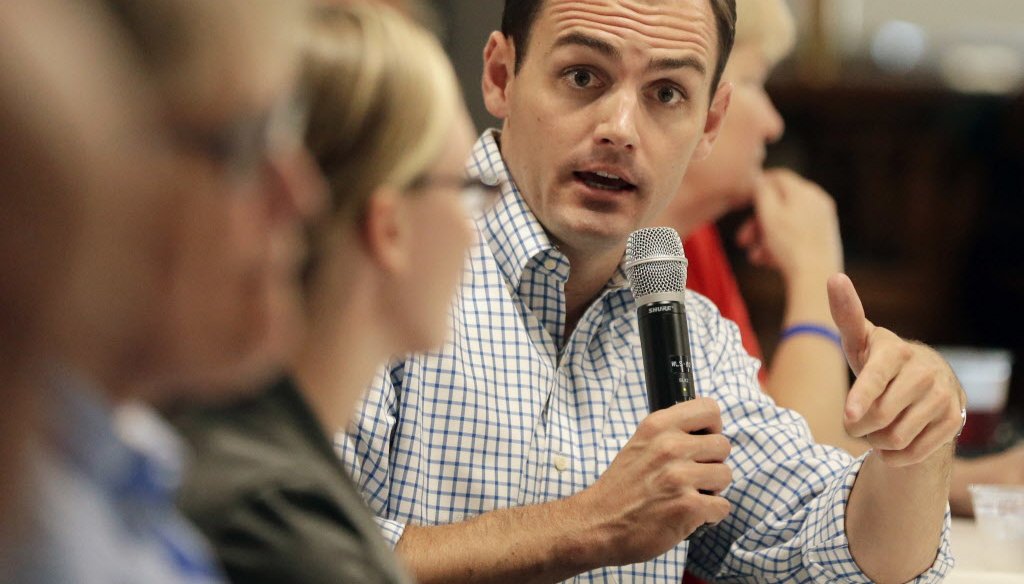Since his arrival in Congress in January 2017, first-term U.S. Rep. Mike Gallagher, (R-Green Bay) has gotten a crash course in health-care politics.
When he was interviewed July 9, 2017, on "Upfront with Mike Gousha," a public affairs show that airs on WISN-TV (Channel 12), Gallagher reiterated his support for repealing and replacing the Affordable Care Act, but said the issues with health care in the U.S. are deeper than those the now-stalled House bill tried to address.
"Whatever we’re doing right now with our health care system is not working," he said, later adding:
"The biggest source of frustration for me, as a new member of Congress, is we’re having this debate over health insurance reform when, really, we need to turn to the drivers of health care costs in this country."
Then he offered this statistic:
"We’re spending 18 percent of our GDP on health care while the average among industrialized countries is closer to 8 percent."
Is he right about the numbers?
The numbers
Gallagher drew his statistics from two reports, according to Madison Wiberg, his communications director.
The U.S. Centers for Medicare and Medicaid Services (CMS) tracks the nation’s expenditures on health care over time. Those numbers show the U.S. spent 17.8 percent of its gross domestic product (GDP) on healthcare in 2015, the most recent year for which data is available.
The 8 percent came from the amount the U.K. spent of its GDP in 2013 (actually 8.8 percent), according to Wiberg. That number came from a 2015 report from the Commonwealth Fund, a private foundation that aims to improve health care systems in industrialized nations through funding independent research.
But Gallagher’s claim referenced the average of all industrialized nations, not just England.
The average high-income nation actually spent 10.6 percent of its GDP on health care in 2015 according to an analysis by the Kaiser Family Foundation.
That gap between the U.S. and other developed nations is longstanding and well-known.
But the difference isn’t one that began with the passing or even the implementation of the Affordable Care Act, often termed Obamacare.
Kaiser found that the gap between the U.S. and other high-income nations has been growing since about 1980. In the four decades since, the percentage of GDP in the U.S. spent on health care shot up from 6 percent (on par with other high-income countries at the time) to the 17.8 percent in 2015.
In comparison, the Netherlands, the next highest spender, used 12 percent of its GDP on care.
When spending is measured by person, the picture is not much different. At $9,451 per person, the U.S. spends almost twice the average for comparable countries, $4,908, according to data from the Organisation for Economic Co-Operation and Development (OECD).
For a while, the rate of growth was slowing, both in the U.S. and abroad.
A 2015 report by The Commonwealth Fund listed the slowdown as a key finding and data from the 2017 annual National Health Spending report by the CMS showed the same slowdown from about 2003 to 2013.
In 2014 and 2015, the major provisions of the ACA were implemented and CMS reported increases in spending growth comparable to periods of recession.
The difference, according to the paper, was "from 2013 to 2015 the number of uninsured individuals fell by 15.0 million, and the insured share of the population reached 90.9 percent."
In other words, the spending went up in part because more people were insured.
More for our money?
While it does not impact our rating, we thought we’d take a quick look at how the U.S. stacks up in terms of outcomes.
According to most recent data from the OECD, American life expectancy at birth was 78.8 in 2015, the 9th lowest of 34 OECD nations (the data does not include Canada).
In a 2013 report, "U.S. Health in International Perspective: Shorter Lives, Poorer Health," authors wrote that even Americans in advantaged demographics -- "white, insured, college-educated or upper income" -- have worse health outcomes than similar people abroad.
The panel found that in addition to obesity and other lifestyle-related issues, Americans are worse off than their foreign counterparts with respect to drug use, HIV/AIDS, lung disease (even though other countries smoke more). The list goes on: Americans are dying of heart disease more often. They’re having limbs amputated due to diabetes complications more often.
In two areas, the U.S. fared better -- Americans are less likely to die from cancer and received better end-of-life care.
"Almost always, Americans were in poorer health," said Steven Woolf of Virginia Commonwealth University, who chaired the National Academies committee that did the report.
The researchers identified five overlapping reasons for the discrepancy: a health system where people lack access to basic care and insurance coverage, behaviors such as alcohol abuse and overeating, social and economic conditions, physical environments (for instance, we drive more than we walk or bike), and public policies and social values that fail to consider health impacts.
Our rating
Gallagher said "We’re spending 18 percent of our GDP on health care while the average among industrialized countries is closer to 8 percent."
His number for the U.S. spending is on target, but the one he uses for other industrialized nations is a bit low. That said, he’s right about his major point: The U.S. has long outspent industrialized nations on health care -- a trend that began long before the implementation of Obamacare.
We rate Gallagher’s claim Mostly True.
div class='artembed'> Share the Facts
2017-08-09 20:35:15 UTC
5
1
7

PolitiFact Rating:
Mostly True
"We’re spending 18 percent of our GDP on healthcare while the average among industrialized countries is closer to 8 percent."
Mike Gallagher
U.S. representative, R-Wis.

In an interview
Sunday, July 9, 2017
2017-07-09




